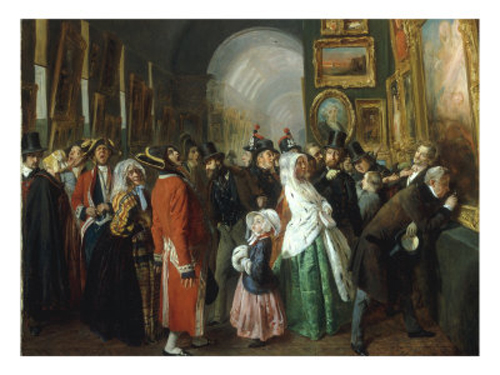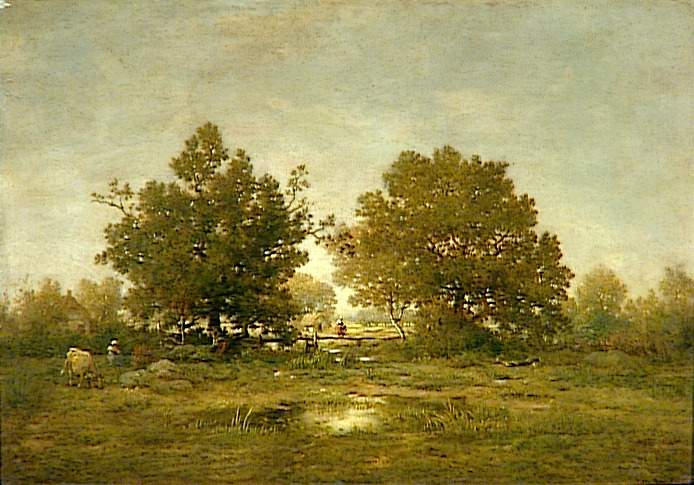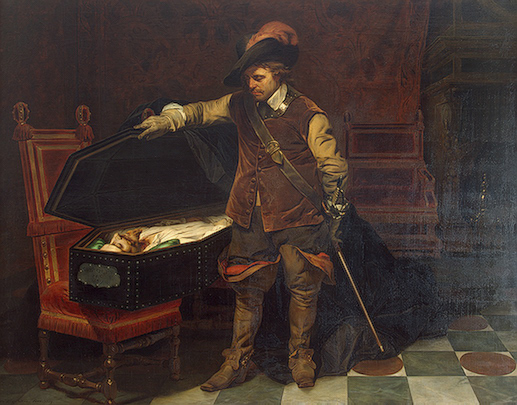F.W.J. Hemmings, “The Art World: Producers and Consumers” from Culture and Society in France, 1789-1848
The Art World: Producers and Consumers
In the passage below F.W.J. Hemmings describes the art world in Paris in the first half of the 19th century. He presents both the increasing problems posed by the expanding art market and the reasons why most artists in the first half of the 19th century chose to continue to work with the context of the official art of the Academy and the Salon.
Just as, in the 1830s and 1840s, Great Britain became the world centre for the production of industrial goods and machinery (a position of supremacy triumphantly
The Salon of 1847 |
asserted at the 1851Crystal Palace exhibition), so, over the same period, France finally established itself as the world centre for the production of works of art. As Lamartine declared in the Chamber of Deputies: 'Paris has become one vast artists' studio. Europe visits, admires, purchases, and exports our products everywhere . . . "Painted in Paris" is a title of honour for a work of art, a certificate of good taste, a guarantee of origin that is in itself a mark of the highest distinction.
The galleries of the Louvre, every spring, became the Crystal Palace on the walls of which these products were hung for the admiration of visitors and, incidentally and indirectly, for sale. Official exhibitions (salons) had been held at irregular intervals throughout the Restoration [the French government after the Revolution from 1815-1830], on average once every three years, but in October 1833 Louis-Philippe signed an order-in council making them annual events. They lasted three months (from March to the beginning of June) with free entry every day except Saturdays when admission was restricted to ticket-holders.
Arrangements for displaying the pictures and pieces of sculpture were far from ideal; only the original Salon Carré of the Louvre was really satisfactory for the purpose, which meant that intrigues to secure the few good places were often frantic. But the frustration caused among artists by the inadequacy of the display facilities was as nothing compared to the fury periodically provoked by the capricious judgements of the committee whose task it was, before the opening day, to pick and choose among an avalanche of entries and decide which works should have the honour of exhibition and which should be rejected. This 'jury', as it was called, was drawn from members of the Academie des Beaux-Arts; its supposed function was to filter out the incompetent and mediocre submissions, to act as a kind of bureau of standards. There were those who felt that under the July Monarchy it was failing to discharge this duty with sufficient rigour. In the opening paragraph of his short story "Pierre Grassou" (1840) Balzac, the perpetual laudator temporis acti [one who praises earlier eras], deplored the laxity of the jury d'examen [the jury that decided which works to accept for the Salon] and recalled with a sigh the good old days when the selection committee really knew its business. Its strictness, he declared, never led to the rejection of a genuine masterpiece, and no complaints were ever heard about the arbitrary procedures of the jury. 'Now that anyone capable of spoiling a canvas can send in his work, we hear of nothing but misunderstood geniuses.'
Théodore ROUSSEAU, Landscape (1885)
|
Certainly dissatisfaction with the verdicts of the examining committee was far more widespread during the July Monarchy than it had been under the Restoration; the reason was probably that the committee members were less sure than they had been what criteria to apply. In some years they were very fierce, rejecting works by reputable painters like Delacroix, Decamps, Boulanger, Chasseriau; in others, as if to compensate, or perhaps because they were frightened by the uproar caused by their earlier display of severity, they seemed prepared to admit the dullest daubs. It would have been pointless to look for any rational policy, though the desire to snub the king or to cock a snook at the ministry may have accounted for certain insulting rejections: of Chasseriau, for instance, an artist highly esteemed by Louis Philippe, whose Cléopâtre was refused in 1845, or of Barye whose animal sculptures had been seen regularly at the salons of 1834, 1835 and 1836, but whose Submission in 1837 was excluded for no other reason, apparently, than that it was known the work had been commissioned by the Due d'Orleans. Thereafter, and for the remainder of Louis-Philippe's reign, Barye refrained from submitting anything.
This policy of 'sulking in one's tent' was also adopted by lngres who, offended at the criticisms made of his Saint-Symphorien in 834, announced it as his firm intention never to exhibit at any future salon; his example was followed, though less consistently, by a number of other painters, among them Ary Scheffer, Delaroche and Decamps. Their reputations stood high enough among the purchasing public for them to be able to dispense with the free publicity the state offered every spring. But most artists, including some of the first rank, did not fall within this category. They needed at all costs to exhibit at the annual salon, since this was almost the only means open to them to achieve the kind of reputation that would enable them to dispose of their works at a reasonable price. Some never succeeded, however often they tried: thus Theodore Rousseau, who became known as 'le grand refuse'. His first attempts, in 183I and 1833, were successful, but in 1836 his large canvas, La Descente des vaches dans le Jura, greatly admired by Jules Dupré and by the republican art critic Théophile Thoré, was refused by the jury, though purchased by Ary Scheffer as an act of defiance. In 1840 all Rousseau's submissions were rejected, and in 1842 the jury would not even pass his magnificent Allee des chataigniers, painted in Brittany the previous summer. In respect of his inability to please the official judges, Rousseau could almost be called the Cezanne of the July Monarchy though, unlike Cezanne who was fortunate enough to have a banker as father, Rousseau had no kind of financial security and depended for his livelihood solely on selling his work; his own father, a tailor, had been ruined through unlucky speculations.
The importance of the salon for the average artist lay in the immense fascination it had not just for the connoisseur, or in a broader sense for the art-loving public,
Paul Delaroche, Cromwell before the Coffin of Charles I (1849) |
but for the mass of ordinary people who in those days were offered little in the way of cultural stimulus and who crowded into the Louvre as soon as the exhibition opened; in 1846 as many as 1,200,000 visitors were reckoned to have passed through its doors. The salon was written up in every newspaper and periodical, by art specialists like Gautier, Baudelaire and Merimee, by literary pundits like Jules Janin, Gustave Planche and Alphonse Karr, by publicists and politicians such as Eugene Pelletan and Felix Pyat. These reviews were serious and sometimes erudite, though the writers rarely embarked on technical discussions. They were supplemented by lithographic reproductions of the more celebrated of the exhibits; in some cases these provide the only record we now have of what they looked like, the originals having long since been lost, destroyed, or painted over.
It may seem a little surprising, in view of the difficulty so many painters encountered in getting a fair showing, that greater efforts were not made to mount independent exhibitions in competition with the salon. The principal obstacle was cost; so long as one could fight one's way in, entry to the official exhibition was free on five days of the week, while anybody organizing a private show would need to charge for admission to meet his overheads. However, towards the end of the period we are considering, one interesting attempt was made to organize a rival display of pictures. In I 842 a bookseller opened a gallery in a departmental store, the Bazar Bonne Nouvelle, in which he displayed a collection of old masters, charging one franc for admission. There were 10,000 visitors. Four years later, in the same locale, a new exhibition was organized, the profits going to the Association des Artistes, a club formed by Baron Taylor to provide pensions for veteran artists fallen on evil days. Here, in quiet surroundings, so different, wrote Baudelaire, from the 'turbulent, garish, noisy, crowded annual exhibitions', the visitor could admire, alongside rarely seen neo classical masterpieces by David, Guerin, Girodet, Gros and Prud'hon, an interesting selection of paintings by living artists including Ingres, Paul Delaroche, Theodore Rousseau, Diaz and Ary Scheffer. The 1846 Bazar Bonne Nouvelle exhibition must be reckoned as the first serious attempt to challenge the monopolistic position of the official salon de peinture; the tradition it inaugurated continued under the Second Empire with the oneman shows of Ingres, Courbet and Manet, and can be said to have culminated in the sensational and hotly discussed salons des independants of the 1870S. . . .
With the slowly increasing prosperity of these years of peace, more and more middle-class art-buyers were making their requirements known and finding ready suppliers. It did not take long for the effects to be noticed in the annual salons, where small easel pictures, of the kind that could be conveniently hung on the walls of a town apartment or a small country retreat, were observed to be increasingly displacing the grandes machines, the large historical or religious compositions that were now rarely undertaken unless specifically commissioned.51 The same tendency towards reduced dimensions showed itself in sculpture, as statuettes replaced statues, and bronze table ornaments came into fashion. There were, of course, conservative critics who mourned the decline of the grand tradition; but the greater danger was the invasion of the whole art world by the crude and tasteless standards of the hundreds of new middle-class purchasers.
The kind of art these people looked for, and bought when they saw it, was not that of a particular group or school, but it had certain definable characteristics none the less. The composition had to be intelligible on the lowest level and pose no problems. Just as there was no mystery about the subject, so there had to be no ambiguity in its presentation. Objects must be clearly outlined and given the colours the ordinary man, who preferred to take such matters on trust instead of using his eyes, assumed they had; so, oranges were orange and violets were violet. It was an eminently conventional art: faces and figures accorded with the currently accepted standards of beauty or nobility. The execution was taken to the point where the work would look 'finished' to the average spectator.
Every picture had to tell a story; many, indeed, could almost be taken to represent scenes from some costume play or pageant. Well-known historical incidents were particularly suited to the purpose, and the painter most successful at exploiting this vein was Paul Delaroche, who specialized in illustrating scenes from British history made familiar to the French by Scott's novels and by the numerous plays and operettas drawn from them. It was a peculiarity of Delaroche's pictures that they would have been quite meaningless without their titles. Two dejected boys sitting on a bed in a darkened room, a man in riding boots looking down at a coffin, such compositions could only have the intended effect once the viewer understood that the first represented the Princes in the Tower about to be done to death by their uncle's hired assassins, and the second Oliver Cromwell contemplating Charles I after his execution.
Contemporary events also found their illustrators, but the bourgeois artpurchaser, who always wanted to be 'taken out of himself', had no time for pictures that showed him familiar scenes of everyday life; hence his refusal to pay any attention to the landscapists of the Barbizon school: all those trees, and never anything more exciting going on than a village priest sitting down to read his breviary .. . But he was delighted with the pictures Horace Vernet painted of battle scenes in Algeria, La Prise de Bone (1835), Le Siege de Constantine (1839), La Smalah (1845). They had the appeal of the exotic and, besides, they testified to the invincibility of French arms, and no one was a stauncher patriot than the average small tradesman and garde national. The popularity of such slick painters as Delaroche and Vernet -- and a dozen lesser men whose names are all but forgotten and whose works are seldom seen today -- constitutes a phenomenon of some importance in French cultural history, since it is here that one can trace the beginning of the rift between the truly creative artist and the mass of the public, a rift which widened into a dangerous chasm later in the century. The hostility that Manet and the Impressionists met with in the 1860s and 1870s, the ostracism to which they were subjected, the lordly disdain of those of their colleagues -- Meissonier, Bastien-Lepage, Carolus-Duran -- who made the concessions they refused to make, all this can be seen as having started under the July Monarchy. The genuinely original artist found he had no channel of communication with the bourgeois who held the purse-strings. A diary entry made by Delacroix on 26 January 1847 has the value of a prophetic utterance: 'Dined with M. Thiers. I have no idea what to say to the people I meet in his house and they have no idea what to say to me.'


